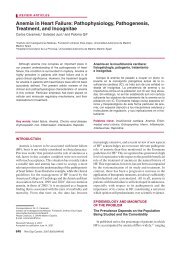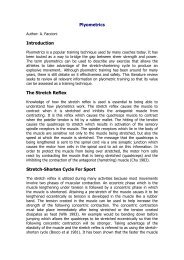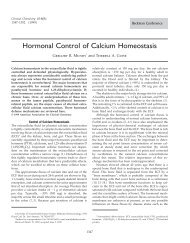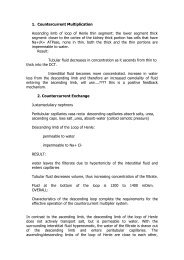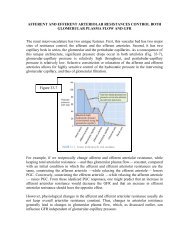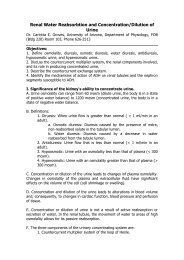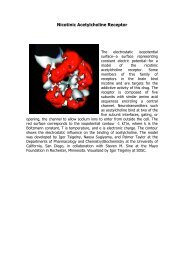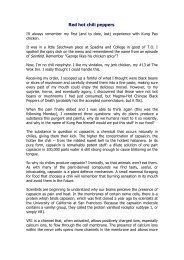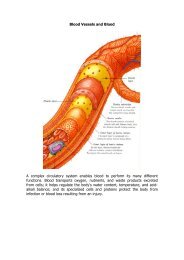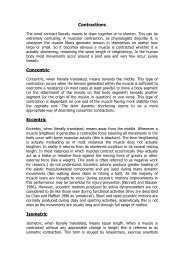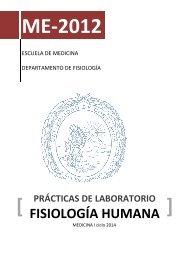Role of Gastrointestinal Hormones in the Proliferation of Normal and ...
Role of Gastrointestinal Hormones in the Proliferation of Normal and ...
Role of Gastrointestinal Hormones in the Proliferation of Normal and ...
You also want an ePaper? Increase the reach of your titles
YUMPU automatically turns print PDFs into web optimized ePapers that Google loves.
Thomas et al. • <strong>Gastro<strong>in</strong>test<strong>in</strong>al</strong> <strong>Hormones</strong> <strong>and</strong> <strong>Proliferation</strong> Endocr<strong>in</strong>e Reviews, October 2003, 24(5):571–599 577tr<strong>in</strong>, G-17, <strong>and</strong> G-34 adm<strong>in</strong>istration. Schwartz <strong>and</strong> Storozuk(91) found that exogenous gastr<strong>in</strong> (13.5 nmol/kgd) enhancedgrowth <strong>of</strong> jejunoileal segments obta<strong>in</strong>ed from 19- to20-d gestation fetal rats transplanted sc <strong>in</strong> adult rats. Inaddition, adm<strong>in</strong>istration <strong>of</strong> gastr<strong>in</strong> enhanced <strong>the</strong> absorption<strong>of</strong> galactose <strong>and</strong> glyc<strong>in</strong>e, suggest<strong>in</strong>g that gastr<strong>in</strong> <strong>in</strong>creasesfunctional activity as well as growth. Subsequent studies,however, us<strong>in</strong>g both pentagastr<strong>in</strong> <strong>and</strong> natural G-17 havefailed to demonstrate significant trophic effects <strong>of</strong> gastr<strong>in</strong> <strong>in</strong><strong>the</strong> small bowel (jejunum <strong>and</strong> ileum) mucosa <strong>of</strong> <strong>the</strong> adult ratas measured by v<strong>in</strong>crist<strong>in</strong>e-arrested metaphase (92). An explanationfor <strong>the</strong>se differ<strong>in</strong>g results is not entirely clear butmay perta<strong>in</strong> to different experimental measures <strong>of</strong> proliferation.Therefore, although <strong>the</strong> trophic effects <strong>in</strong> <strong>the</strong> oxyntic<strong>and</strong> duodenal mucosa are well established, <strong>the</strong> trophic effect<strong>of</strong> gastr<strong>in</strong> <strong>in</strong> <strong>the</strong> rema<strong>in</strong><strong>in</strong>g small <strong>in</strong>test<strong>in</strong>e is currently consideredm<strong>in</strong>imal, at best.3. Colon. Similar to <strong>the</strong> small bowel, evidence for a trophiceffect <strong>of</strong> gastr<strong>in</strong> <strong>in</strong> <strong>the</strong> colon is limited. In earlier studies byJohnson (93), adm<strong>in</strong>istration <strong>of</strong> natural porc<strong>in</strong>e gastr<strong>in</strong>s stimulatedDNA syn<strong>the</strong>sis <strong>in</strong> <strong>the</strong> colon. In contrast, hypergastremia,<strong>in</strong>duced through acid blockade by ei<strong>the</strong>r omeprazoleadm<strong>in</strong>istration (94) or fundectomy (95), failed to produceproliferation <strong>of</strong> ei<strong>the</strong>r normal colon or <strong>the</strong> colon carc<strong>in</strong>omacells transplanted from an orig<strong>in</strong>al 1,2-dimethylhydraz<strong>in</strong>e<strong>in</strong>ducedadenocarc<strong>in</strong>oma.As opposed to results us<strong>in</strong>g amidated gastr<strong>in</strong>, recent experimentsus<strong>in</strong>g G-gly demonstrate colonic proliferation,spark<strong>in</strong>g renewed <strong>in</strong>terest <strong>in</strong> a role for gastr<strong>in</strong> precursorproducts <strong>in</strong> colonic growth. Koh et al. (96) generated micethat overexpress progastr<strong>in</strong> truncated at glyc<strong>in</strong>e-72 (MTI/G-GLY), which demonstrates elevated serum <strong>and</strong> mucosallevels <strong>of</strong> G-gly compared with wild-type mice. MTI/G-GLYmice display a 43% <strong>in</strong>crease <strong>in</strong> colonic mucosal thickness <strong>and</strong>a 41% <strong>in</strong>crease <strong>in</strong> <strong>the</strong> percentage <strong>of</strong> goblet cells per crypt.Fur<strong>the</strong>rmore, adm<strong>in</strong>istration <strong>of</strong> G-gly to gastr<strong>in</strong>-deficientmice resulted <strong>in</strong> a 10% <strong>in</strong>crease <strong>in</strong> colonic mucosal thickness<strong>and</strong> an 81% <strong>in</strong>crease <strong>in</strong> colonic proliferation (as measured byBrdU) when compared with control mice. Thus, <strong>the</strong>se data,us<strong>in</strong>g exogenous adm<strong>in</strong>istration <strong>and</strong> genetic mouse models,demonstrate that G-gly is a potent stimulator <strong>of</strong> colonicproliferation.4. Pancreas. The role <strong>of</strong> gastr<strong>in</strong> <strong>in</strong> normal pancreatic growthis also believed to be stimulatory. In two separate studies,<strong>in</strong>vestigators <strong>in</strong> our laboratory have demonstrated small,albeit significant, <strong>in</strong>creases <strong>in</strong> pancreatic growth. In <strong>the</strong> firststudy, young adult rats were given pentagastr<strong>in</strong>, NT, or BBS<strong>in</strong> comb<strong>in</strong>ation with an elemental diet (ED) (33). Pentagastr<strong>in</strong>at a maximal dose, 250 g/kg, <strong>in</strong>creased pancreatic weightcompared with control rats. In <strong>the</strong> second study, pentagastr<strong>in</strong>(100 g/kg) was given to young (3-month-old), adult(12-month-old), <strong>and</strong> aged (24-month-old) rats (97). In youngrats, pentagastr<strong>in</strong> <strong>in</strong>creased pancreatic weight, DNA, RNA,<strong>and</strong> prote<strong>in</strong> content. In adult rats, however, pentagastr<strong>in</strong>only produced <strong>in</strong>creases <strong>in</strong> RNA content, whereas aged ratsshowed no trophic effect. These results suggest that <strong>the</strong> effects<strong>of</strong> gastr<strong>in</strong> on pancreatic growth are dependent uponage. Fur<strong>the</strong>r support for a stimulatory effect <strong>of</strong> gastr<strong>in</strong> onpancreatic cells is provided by <strong>in</strong> vitro studies us<strong>in</strong>g <strong>the</strong> ratpancreatic ac<strong>in</strong>ar cancer cell l<strong>in</strong>e, AR42J, demonstrat<strong>in</strong>g thatgastr<strong>in</strong>s can <strong>in</strong>duce cellular proliferation through stimulation<strong>of</strong> <strong>the</strong> c-fos transcription factor via prote<strong>in</strong> k<strong>in</strong>ase C-dependent <strong>and</strong> <strong>in</strong>dependent mechanisms (98).In contrast, Chen et al. (99) <strong>in</strong>duced hypergastr<strong>in</strong>emia <strong>in</strong>male Sprague-Dawley rats by cont<strong>in</strong>uous <strong>in</strong>fusion <strong>of</strong> humanLeu 15-gastr<strong>in</strong>-17, by fundectomy, or by treatment with omeprazole.Gastr<strong>in</strong> <strong>in</strong>fusion or omeprazole treatment did notaffect pancreatic weight <strong>and</strong> DNA content, whereas fundectomy<strong>in</strong>creased pancreatic weight <strong>and</strong> DNA content. Thesef<strong>in</strong>d<strong>in</strong>gs suggest that endogenous gastr<strong>in</strong> level variations donot directly play a role <strong>in</strong> pancreatic growth. Fur<strong>the</strong>r studiesare needed to conclusively establish <strong>the</strong> differences <strong>in</strong>gastr<strong>in</strong>-related hormonal signal<strong>in</strong>g affect<strong>in</strong>g <strong>the</strong> growth <strong>of</strong><strong>the</strong> pancreas.B. CCKCCK, act<strong>in</strong>g through CCK-A receptors, is one <strong>of</strong> <strong>the</strong> mostpotent secretagogues regulat<strong>in</strong>g pancreatic ac<strong>in</strong>ar cells (100).Additionally, CCK stimulates <strong>the</strong> growth <strong>of</strong> <strong>the</strong> pancreas <strong>in</strong>experimental studies (101, 102). However, evidence for CCKplay<strong>in</strong>g a major role <strong>in</strong> <strong>the</strong> growth <strong>of</strong> <strong>the</strong> GI mucosa (stomach,small bowel, <strong>and</strong> colon) is limited.1. GI mucosa. Adm<strong>in</strong>istration <strong>of</strong> CCK <strong>and</strong> secret<strong>in</strong> preventedatrophy <strong>in</strong> <strong>the</strong> jejunum <strong>and</strong> ileum <strong>of</strong> dogs given total parenteralnutrition (TPN) as a sole nutrient source (103). Inaddition, adm<strong>in</strong>istration <strong>of</strong> <strong>the</strong>se peptides <strong>in</strong>creased galactoseabsorption, suggest<strong>in</strong>g that CCK is a positive enterotrophicfactor for <strong>the</strong> gut. Weser et al. (104) provided additionalevidence that CCK alone, or <strong>in</strong> comb<strong>in</strong>ation withsecret<strong>in</strong>, could prevent TPN-associated jejunal <strong>and</strong> ileal atrophy<strong>in</strong> rats. In subsequent studies, F<strong>in</strong>e et al. (105), us<strong>in</strong>g<strong>in</strong>test<strong>in</strong>al bypass models, demonstrated that <strong>the</strong> trophic responsenoted by CCK <strong>and</strong> secret<strong>in</strong> <strong>in</strong> <strong>the</strong> small bowel was <strong>the</strong><strong>in</strong>direct result <strong>of</strong> <strong>in</strong>creased pancreatobiliary secretion, as opposedto a direct stimulatory effect <strong>of</strong> <strong>the</strong>se peptides on <strong>the</strong>gut mucosa. Confirmation <strong>of</strong> <strong>the</strong> lack <strong>of</strong> a direct effect <strong>of</strong> CCKon small bowel growth was provided by Stange et al. (106)us<strong>in</strong>g cultured rabbit jejunum <strong>and</strong> ileum preparations.2. Pancreas. In contrast, <strong>the</strong> trophic effects <strong>of</strong> CCK on <strong>the</strong>pancreas have been demonstrated by a number <strong>of</strong> experimentalmodels (107–113). In one study, <strong>the</strong> effects <strong>of</strong> camostate(400 mg/kg), a potent <strong>in</strong>hibitor <strong>of</strong> tryps<strong>in</strong> (which blocksser<strong>in</strong>e proteases), were compared with <strong>the</strong> effects <strong>of</strong> chronicexogenous adm<strong>in</strong>istration <strong>of</strong> CCK-8 with or without adm<strong>in</strong>istration<strong>of</strong> <strong>the</strong> CCK-receptor antagonist, CR 1409 (114).Chronic (10-d) camostate feed<strong>in</strong>g <strong>in</strong>creased pancreaticweight, prote<strong>in</strong>, <strong>and</strong> DNA content, which was associatedwith <strong>in</strong>creased CCK plasma levels. The adm<strong>in</strong>istration <strong>of</strong>exogenous CCK produced similar <strong>in</strong>creases <strong>in</strong> pancreaticgrowth. The comb<strong>in</strong>ation <strong>of</strong> camostate <strong>and</strong> CCK-8 producedan additive stimulatory effect on <strong>the</strong> pancreas. The CCKreceptorantagonist, CR 1409, completely abolished <strong>the</strong> trophiceffects <strong>of</strong> exogenous CCK-8 <strong>and</strong> <strong>in</strong>hibited <strong>the</strong> effects <strong>of</strong>chronic camostate feed<strong>in</strong>g. Fur<strong>the</strong>rmore, CR 1409 alone decreasedpancreatic weight, DNA, <strong>and</strong> prote<strong>in</strong> content <strong>of</strong> rats.Additionally, o<strong>the</strong>r studies have substantiated <strong>and</strong> con-Downloaded from edrv.endojournals.org by on July 16, 2007



